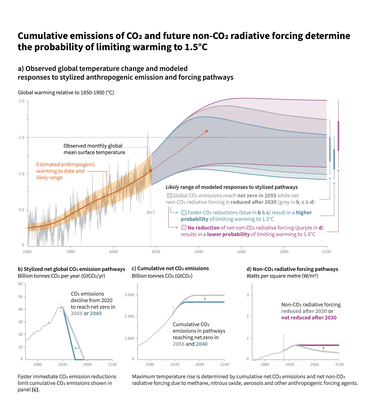Understanding Global Warming
Note that this page is based on information from the "IPCC SR1.5 Summary for Policymakers". For more information on global warming go to the following page on this website: Global Warming
Recent Global Warming

Source: IPCC SR Limiting Warming to 1.5°C
Since pre-industrial times (1850-1900) human activities have caused approximately 1.0°C of global warming to occur. (Current temperature is based on global measurements in October 2018, the date of the IPCC SR15 report.) In comparison, the global mean surface temperature (GMST) for 2006-2009 was 0.87°C higher than the average from 1850-1900.
The rate of warming has been estimated at approximately 0.2°C per decade, due to past and ongoing emissions of greenhouse gases.
Global Variations
The amount of global warming is not uniform over all areas of the Earth. There are variations from one area to another and in different seasons. For example, in the Arctic warming has taken place to a degree 2-3 times greater than the global average. Likewise, warming over land areas is usually greater than warming over the ocean.
Extremes
Increases in both intensity and frequency of various weather extremes have been detected during recent times when global temperature has risen about 0.5°C. This assessment is based on research extending back to 1950.
Predictions
Warming from anthropogenic climate change that has already occurred will continue for centuries to millennia and will continue to cause long-term changes in the climate system. However, current changes alone will not likely cause global warming of 1.5°C. It will require more anthropogenic global warming to produce global warming that will raise median global temperature to 1.5°C. The task before us is curtailing the generation of greenhouse gases by decreasing the burning of fossil fuels and other methods, in order to limit global warming to 1.5°C or less.
Climate Related Risks
Climate-related risks are higher for global warming levels of 2°C than for levels of 1.5°C. The risks involved depend on a number of factors:
- magnitude and rate of warming
- geographic location
- levels of development
- vulnerability
- mitigation and adaptation options
Future risks depend on the rate, peak and duration of global warming. Some future impacts may be long-lasting or irreversible, such as loss of ecosystems or species extinction.